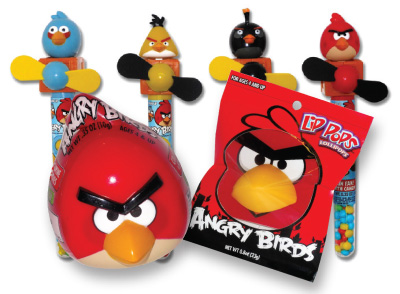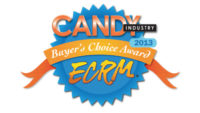ECRM Buyers' Roundtable
Candy Industry recently hosted a Buyers' Roundtable discussion at the ECRM show in New Orleans.

The Participants Include:
|
Lee Garro // Jack’s World, senior buyer |

|
|
Tom Montgomery // MAPCO, category manager for candy |

|
|
Chris Lanoue // category manager for general merchandise, candy, and seasonal at Shaws Supermarkets |

|
|
Nancy Smith // Sweet Factory, director of merchandising |

|
|
Bear Silber // Powell’s Sweet Shoppe, ceo/owner |

|
|
Crystal Lindell // managing editor, Candy Industry |

|
Candy industry: Thank you all so much for coming and taking the time to do this and to be here today. I’m really excited to hear a lot of the thoughts you have about the industry and about the show, and I’m hoping that we can have some really fruitful discussion about different things that are going on within the confectionery world. So obviously, all of you have a plenty of meetings at shows like this, and you see a wide range of products. So what kind of things stand out to you and what kind of products really catch your eye?
MONTGOMERY:At least for me, like I said, I’m accustomed to traditional c-store offerings. So I’m going to see the Hershey’s and Mars and the Wrigley’s all day long. But to be able to come in here and see some of the Ghirardelli and Thornton’s and some of those higher-end items makes a real great impression on me because it’s exactly where I want to take our business.
SILBER:To me, what stands out even more, are the new flavors and the better ingredients, which are actually a huge difference nowadays for me. I’m looking at higher quality stuff, more organic stuff, no high fructose corn syrup, that sort of thing.
MONTGOMERY:I call it cheating without cheating. We’re all being told we need to be healthier with diabetes and obesity and everything else. But we still love our sweets. And you can eat some of these offerings, for instance, a Brookside, that’s really good, and yet you don’t feel like you’re doing anything that bad simply because the doctor himself will say moderation is good for you.

|
Does premium sell?
CANDY INDUSTRY: Many consumers say that they want higher-end, better-quality products, but they don’t always buy those products, such as organic confections, when they discover the items are more expensive, despite containing better ingredients.
GARRO: I find that they want it. But then when you bring it in, they really don’t want to pay for it.
SILBER:It’s less than they’re talking about.
GARRO:Like with food, with chemicals, they do want the organic. They want to feel like they’re participating, but they don’t want to pay for that.
LANOUE:Brookside may be a one off because I would tend to agree with you. But this year Brookside, for me, has brought a new customer down the aisle, somebody who wasn’t shopping there before. And that’s completely incremental growth because the first four weeks of my summer, Twizzlers was the number one item by far on the Northeast. Brookside was actually outselling Twizzlers in my stores for the first four weeks of summer.
MONTGOMERY: And to piggyback off of that a little bit, I think if we stick with our core customer, what you’re telling me is going to be correct; they want it, but they don’t want to pay for it.
GARRO: I do mostly gourmet. We do Lindt. We do Ghirardelli, Almond Roca, and I sell lots. And they’ll go for a brand. They go for taste. They really want the good chocolate bar, a good tasting candy. And some of the manufacturers are coming out with a smaller bar. If they’re coming out with a 1.2-oz. bar, it’s a single-serve. So that’s what I’m looking for. I also think it’s a great way to introduce an expensive bar to the public. They’ll pay 99 cents before they’ll pay between $2.99 and $3.99.
SILBER:Premium items are doing extremely well for me, like, Vosges. Their large bars retail for almost $8. And we have more expensive bars, too, and we don’t have a problem moving them. But, the 1.2-oz. bars, they are just flying off the shelf.
GARRO: We need those sized bars. And I remember telling Lindt when they come out with the little squares, I have a problem with pilferage. There’s just too many people in the store. So I said, “Come out with a little bigger bar, let them taste the chocolate.” There’s a huge difference between that and Hershey bars and Mars. And once you get them tasting a good chocolate, it might be a treat. But that’s OK, they’ll buy it.
SMITH:We are a true candy store. While there are good-for-you, organic, all-natural, kinds of candy available, we have found that when it comes right down to it, our customer wants something decadent. If we’re offering a loaded, sea salt caramel creation, vs. a sort of good-for you option, they’re going to go for the decadent. We carry all the bad stuff. But I like the smaller packaging. Sell a little bit smaller package of your decadent item, and it’s OK.
GARRO:I think organic still has a way to go on some of the flavorings. Some of them don’t taste good.
SILBER:And obviously the price tag that goes with it.
GARRO: And that’s important. If you want to introduce organic, you have to introduce a great product. Because if they have to pay for it, it has to taste great and not all of them do.
SILBER: There’s Unreal. For what it is. It’s not quite organic, but it’s good, Unreal is good. It’s all-natural, whatever you want to call it. And it’s a lot better.
LANOUE:They seem to have bottomless pockets for advertising too. At least in my market, they’re on the number one, two, and three radio stations. They’re in morning traffic, constantly. Constantly, they’re on the radio.

|
Packaging’s importance
GARRO: I think color has to start coming into product [packaging].
CANDY INDUSTRY: Like in packaging?
GARRO: In packaging. You have three seconds to get their attention. I was looking at Nutffles. They do great color on their packaging, the lime greens, and the reds, and the violets. And it just draws them to it. Because if you have so much product in the store, you don’t see it. Chocolate is almost always brown.
SILBER:There is black. Then they started doing white, though. Now, it’s back to black.
GARRO:If it’s just white, it just blurs in.
SILBER:To be honest, I think gold is going to be the next color, lot of gold.
GARRO: It will also blend in.
CANDY INDUSTRY:When you see a really delicious product that you think will sell well, if the packaging is not that great, will you pass on it or will that affect your decision?
GARRO:It will. Because, if I don’t understand it, my customer will never get it. And that’s very important. It has to sell itself.
MONTGOMERY: Packaging is everything. I mean, whether we want to admit it or not, we stereotype everything in our lives. If I walk in here in a suit, you have a different perception of me than if I walk in with a tie-dye shirt and a pair of shorts. Candy is the same way. You can look at something, especially if you don’t know the name, and you just go, “I never heard that, but God that must be the high-dollar stuff because it sure looks good,” versus “It could be the high-dollar stuff, but it’s got cheap packaging,” they think that’s cheap.
CANDY INDUSTRUY: So will you communicate that sometimes to the companies?
GARRO:We talk about it.

|
Selling gummies and lollipops
CANDY INDUSTRY:So moving on to non-chocolate, what are some of the things you look for in that category and what kind of things stand out?
SILBER: We do a ton of bulk. So there’s that, gummies, jelly beans.
MONTGOMERY: The media tells us that sugar is poison for us now. So when you read “made with real fruit” and “allergy conscious” and all that, it makes you feel like, “I’m not doing something bad, I’m getting something that’s good for me.”
SILBER: It’s starting to get back to the point where price is not mattering as much as taste, as quality.
SMITH:I think price still is really important, especially those who shop with a family. We’re in some high-end malls too. But that mother still has several kids. She has to buy shoes and clothes and everything else. But gummies, we look for new shapes, new colors, new flavors, Hello Kitty gummies. Licensing has gone off the charts recently. Candy with licensing, whether it’s a tie-in with a movie or with a show, it’s an extra advertising for all of us selling those candies.
GARRO: Candy is dessert. It’s a treat. If you’re feeling bad, you’re going to eat something. It makes you feel good. It’s a feel-good. And I think gummies, gummies aren’t for kids. They are, but if you figure out when gummies came out, they’re adults now. And they’ll still gravitate. They even like the sours. Yes, children love it. But all the mothers are buying it too. But licensing is very important. I think people believe, well, if they have the license, then there is some quality control in the item.
CANDY INDUSTRY: What about lollipops?
LANOUE:They are taking the sticks off of them. Like Charms are going with the stickless Blow Pops for Valentine’s Day, I think.
SILBER: There’s a new company, a very small company [Lollyphile]. He does Blue Cheese Lollipops and he does the Breast Milk Lollipops. They’re selling really well. But he also has White Russian, Mohito, Bourbon.
GARRO: Have you tasted them?
SILBER:I actually have.
CANDY INDUSTRY: The [Breast Milk lollipops] have a sweet milk flavor.
SILBER:Original Gourmet has amazing flavors.
MONTGOMERY:If I’m going to carry it, to your point, I’m going to carry that higher-end trinket type lollipop that sends the overall message versus the low-dollar children’s blow pop.
LANOUE:I’d rather sell a higher retailed item, get more dollars in the basket than something that’s 59 cents.
SILBER: I try to distance myself from Walgreens, Walmart, Target, as much as possible. You can get Charms all day there.
MONTGOMERY: Well, especially, at the C-store environment, you have limited space. And I have to look at that 6 inches or that 4 inches and say, “Is this the item that’s going to generate the most revenue, yes or no? And if not, what is something else I can put in its place?” And when you make that decision, obviously something has got to go.

|
Targeting 20-Somethings
GARRO: Just with everything changing so rapidly, like I look at what are the 20-year-olds, what are they going for now?
LANOUE:Caramels are coming back.
SILBER: I think bacon in anything. But then when you get chilli peppers in chocolate and those types of things, the more off-the-wall flavors, the crazy flavors, like breast milk. They’ll try it. They’ll talk about it. And then it’s something they spread on social media.
LANOUE:Do you think you get a lot of repeat customers with breast milk lollipops?
SILBER:It’s not a good seller, but it has the attention. But bacon is surprising.
GARRO:Anything with bacon in it.
CANDY INDUSTRY: And what about organic and Fair Trade. Is that trending?
GARRO:They really always have the social presence.
LANOUE:The 20-somethings don’t have the money to keep buying the Fair Trade kind of stuff, at least in my market.

|
Novelty candy trends
CANDY INDUSTRY: So I know we touched on licensing with novelty. What trends are you seeing, or what do you look for with novelty? What kind of price points do you like to keep it at? Because I believe novelty tends to priced be a little higher, or does it?
GARRO:It depends. You can get items for 99 cents, $1.99. I don’t think there’s enough boy items out there. There’s always tons of girl items. The boys items follow the movies, but profit doesn’t always follow the movies. So it’s a tough market.
MONTGOMERY: I wouldn’t bring it in anymore. Our experience has been it comes in, it’s tied to the movie, whatever, it’s a big seller for a very short period. And then I’m writing off the rest of the inventory.
LANOUE: It’s tough to display too.
SMITH:We do a lot with novelty candies. Our vendor community has done such a great job with timing. Like Monster’s University, the candy community was ready in May. They shipped in May. The movie came out in June. We’re like on third reorders of that. That’s pretty unusual. That was one of the best launches ever and sold so well. But it’s in, it’s out, so now we’re done with it. If you can get the timing right, that’s important. But really, hats off to our vendors. They have done a better job getting it before the movie.
LANOUE: You need the timing right. But even more so than that is you need to get retail on board and executing it correctly. That’s the biggest struggle I have. I have 100,000-sq.-ft. stores. And you send them a shipper and Monster Inc.’s spinners. And it sits out back.
SILBER:I think what helps a little bit on licensing, too, is when it’s multiple products.
CANDY INDUSTRY:I was going to ask you that. Do you just get aMonsters University package or do you pick out different products?
SMITH:We did an assortment of Monster’s from an assortment of vendors. Then we worked our bulk, blue and green, to go around with it and balloons. We just made a whole event out of it. Those events will make your weekend. With vendor participation, some of them will give you a sign or a freebie or something additional just to draw additional attention to it. That makes a big difference.
SILBER: Angry Birds was a good example. You can get between the plush and all the different gummies, and then they put on everything. Then it creates that bigger wow factor.
LANOUE:It’s still a good license. The peak was about a year and a half ago, but it’s still a strong license. They are coming out with an animated series. It should maintain.
CANDY INDUSTRY: And then Hello Kitty.
SMITH: It never stops. That’s amazing.

|
Researching the category
CANDY INDUSTRY:Where do YOU research your category? Is it through shows, magazines, online?
SMITH:Yes, yes, yes!
CANDY INDUSTRY:Do you go to other stores?
SILBER:Yes.
MONTGOMERY:I tell you what we do, honestly. I’m sure we’re all in this boat, is hey, Hershey, hey, Mars, what is your research telling you? They’ve already done the work because the Walmarts and Targets of the world have demanded it. And all I’m asking is share some of it with me. And it doesn’t always apply to me. But I can take little golden nuggets out of it and execute against them.
LANOUE:You got to take what Hershey tells you with a grain of salt.
MONTGOMERY:No question. Here’s the advantage, though. Because I am so nimble, for instance, if you came out with something hot today, Walmart is probably not going to move on it for six months. I can literally send out an email today that says remove these two items and place these two in. I’m able to move quickly on the trends much more so than our bigger retail giants.
SMITH:Besides visiting brick-and- mortar stores, Online is also a great resource for newness. There’s a couple of very good websites: Candy.com, Candywarehouse.com. They’re canvassing the market too. When I go to Vegas, I go from candy store to candy store to see if there is anything new. When you go to some of the new candy stores, it’s an event. It’s interactive. You can do things. There’s music and videos. Going to a candy store now is an experience. And for those of us with traditional stores, we’ve got to step it up a little bit because it’s become very edgy — though some of it is too edgy for our particular demographic.
MONTGOMERY: Candy is like legalized crack. It really is. It’s, to me, the greatest category in the world because everybody likes it. There’s some type of candy that you like. Everybody likes candy.
SMITH: It’s really kind of a low-risk investment, too. I’m a former apparel buyer. And so if you wanted to test an item in apparel, you’re talking $50, $100 item. Candy, you want to try a pack? Okay, test it, go, and then you roll it out. If it tastes good, it’s going to work.
LANOUE:I could be very boring with my research. I still use Nielsen and IRI. We have so many competitors that you have to stay on top of it. Yeah, you need to go to shows and stay out in the field, but you need to stay on top of your data.
CANDY INDUSTRY: So you’re looking at data like what’s selling, the top brands?
LANOUE:Yes. You see your rationalization is correct or at least you’re in the ballpark where you should be. You’re not missing any opportunities because there are dollars you’re losing every day.
MONTGOMERY: Part of my research, I know this is going to sound crazy, but people bring me samples, which I put it in my office. It sit on my desk for six weeks. If I can’t give it away, I’m not selling it. But if people go, “Hey, dude, you got any more of them?” Then, I know if it’s moving that fast in here, it’s going to move out there.
MONTGOMERY:And we trust our own taste buds. We know what’s good. There’s got to be at least a few people in the world like me. If I love it that much, some other people are going to like it too.
CANDY INDUSTRY:Is it kind of hard to judge what you like versus what will sell?
MONTGOMERY: Numbers are a self-fulfilling prophecy. If I brought in two brownies and ten chocolate bars, which one you think sells the most? The ten chocolate bars. What I didn’t know, unless I have research, is that everybody wanted a brownie, and they settled for that because that’s all I had.
LANOUE: If I have a bunch of new items coming in for a season —say Palmer comes out with 75 laydown bags— I’ll put them out. We have a ton of category managers that have been doing what they do for a long, long time. So they know and they’re consumers, too. So I’ll say, “Try it. How much would you pay for it?” It’s as simple as that. And if they are not in the ballpark, see you later. I trust them. They’re my customer as much as any of my actual customers.

|
Seasonal candy sales
CANDY INDUSTRY:How important is seasonal candy and how does one stay on top of it given the need for exact timing?
LANOUE:Probably about 40 percent of my total candy business is seasonal. Huge, huge.
CANDY INDUSTRY: So how do you manage that?
LANOUE:We still use, for the time being, Hershey nav. through Supervalu. And we’re still going to be using that in the foreseeable future. Hershey can pull POS data, and they do all the legwork behind the sell-through. I have so many stores and so many SKUs that they work all that out, including which store sold X amount of this item. It builds your order for you taking out new items.
So I go through the SKU rationalization process, decide what items from last year I keep, decide which of the new ones I’m bringing in, decide which ones are going to be deleted. And it’s just a grind. You can do it five times a year. There’s no easy way around it.
MONTGOMERY:It’s like novelty. You have to plan well on the front-end and have your exit strategy on the back-end. If you don’t do a really good job at that, then you’re stuck with writing off a bunch of seasonal candy.
GARRO: Well, we have to have it because if we don’t have it, they’ll come in and they’ll walk right out. They’re on a mission when it comes to seasonal candy. It’s not going into a store and saying, “What can I eat?” They need to get stockings, baskets, whatever, filled.
CANDY INDUSTRY:Do you have to bring in a lot of different items each year? Are you constantly trying to manage that? How do you work on things like that?
MONTGOMERY: I want two or three big seasonal hitters. I don’t want everybody to be my seasonal candy.
SMITH:Wide assortment, huge assortment. We look so forward to it. We plan it all year long. We make the front of the store seasonal, and we just go crazy with it. I mean, we change the color of our bags to red.
SILBER:It’s true. Our entire store takes on each season, the whole look. It’s all fully decorated. We’re almost always in a season. We have summer as a season, and there’s maybe a month on either side. Toffee, and sodas, there’s a lot of stuff you can do.
LANOUE:It’s a huge opportunity in summer everywhere, no matter where you go. I don’t care how good you do summer, there’s a huge opportunity in summer.
MONTGOMERY:So you hit Valentine’s, you hit Easter, you hit summer.
SMITH:Mother’s Day, Father’s Day, football. We added football this year.
SILBER: We did Grammy’s this year. We have one table that’s completely seasonal always, but then the entire store is decorated.
GARRO:We’ll bring in the seasonal and then because we don’t want to get stuck and do all the markdowns and everything, then we’ll back that up with everything novelty. Put that Christmas out, Halloween out. And then if that’s going out, then we have other novelties that can work in that category. But it’s every day.
SILBER:We look for items that can probably get away with other seasons. Like a heart, but it doesn’t say “love you” or something.
SMITH:Or it’s Easter, it’s spring. It’s not so much an Easter bunny.
GARRO:And it will grow into Mother’s Day.
SILBER:We sell all our seasonal stuff. What we do is we honestly sell almost all of it by the day of. But then the next day it’s 25 percent off, 50 percent off, 75 percent off, three days after it’s gone.
GARRO: That’s hard for us. There’s one candy that will never sell no matter what you mark it down is Easter. That’s the worst holiday to get stuff sold.
SMITH:Halloween is hard too because people have leftovers from what they have handed out, and they don’t want leftover Halloween.
SMITH:The vendors are doing a lot better with gift boxes putting a sleeve on it, Valentine sleeve, take it off.
LANOUE: Stover does a great job with that.
SMITH:Russell Stover, Jelly Belly does the same thing.

|
The next big trends
CANDY INDUSTRY: What do you see as the next big trend in candy?
MONTGOMERY:I’d say better-for-you, because massive obesity rates in this country, massive diabetes in this country, yet people are not going to give up their love for sweets. They are looking for some healthy alternatives.
SILBER:That’s a longer-term thing though. That’s 25, 30, 40 years out. But I don’t think it’s going to be really, really a serious thing for a while.
LANOUE:We’ve already seen it, but standup pouches with re-sealable bags, portion control. If it’s not already a trend, it will be everywhere. Not only do people like the portion control, it presents way better on the shelf than a lay-down bag. And manufacturers love it because they’re putting less product in it and selling it at the same retail as the lay-down bags.
SILBER:I’m trying to do local manufacturers, local sponsors. In San Francisco, that’s pretty easy. We have a lot there. But even our stores in Pasa Robles or San Jose, we try to get items produced from around there. It’s something the customers love. Anything from San Francisco, in San Francisco, sells.
GARRO:I think sensation, taste, like sweet and salty. If it gets all different taste buds going, that’s really coming up.
SILBER:You can do anything. People will add anything to candy. Bacon, I mean, who would have thought of that ten years ago?
MONTGOMERY:Cayenne pepper chocolate. You don’t think of that, but yet you eat it and go, “Oh my gosh, it’s really good!”
SILBER: Yeah, get the local stuff because those guys — if you go into your local candy shop that’s making it handmade, they’ll try anything, and they can do it in small batches. And if it doesn’t sell, they just go on to the next flavor. But that’s a good place. That’s where I do a lot of my research, the local shops.
MONTGOMERY:Prices really are going to have to come down or sizes are going to have to come down. Because I tell you people, budgets are tight, fuel is not going anywhere any time soon. And when it comes to baby needs — milk or my chocolate bar — I know which one is going to win that battle.
LANOUE:And another thing, at the end of last year, at least in my market for Halloween,KitKat jumped over Reese’s for number one. Many parents can’t give peanut butter to their kids to bring to school. So Reese’s is still Reese’s. People are going to buy it and eat it, but you can’t even send a kid with a peanut butter and jelly sandwich, never mind a Reese’s.
SILBER:Another really good flavor that’s going to start doing more and more is wine or beer, even, ale stuff, like, Cabernet grapes and Chardonnay mixed with it and then also cocktail stuff.
CANDY INDUSTRY: In the chocolate you mean?
SILBER:Yeah, some actually do use wine, not much. Usually, it’s more of the grape. And then you have all the cocktail-flavored items. That’s going to be like that 20-year-old group, maybe a little bit older, to 30-year-olds.
GARRO:They’ve gone back to the old drinks, the Manhattan.
CANDY INDUSTRY: Thank you all for coming. We had a great conversation and it was enlightening.
Looking for a reprint of this article?
From high-res PDFs to custom plaques, order your copy today!






